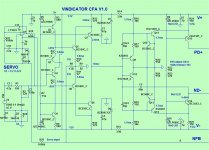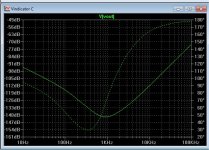1500A
If you asked I might have given you the one I have
Or mine. All the manuals, tapes and the vinyl record. Might even still work.
All good fortune,
Chris
No folded cascode. Too exotic .
I have two building this now. It is folded cascode all the way.
I used Sam Groner's Final TIS for the right hand (folded) stage. I was surprised
to see that -140db 1K PSRR at output. No other design even comes close.
THD and slew are secondary to how an amp rejects it's dirty PS !!
OS
Attachments
Last edited:
ostripper,
Glad you piped in, it was your conversation with others that I was pointing to without naming names.
Me and Vzaichenko are the new wave.
Some of these (old) new adaptations will define the forum.
Doug self "blamelesses" are sooooo boring.
That last "groner" IPS will do 6ppm right up to 130V p-p.
Symmetrical "rules". (I am NOT in the self camp).
OS
That last "groner" IPS will do 6ppm right up to 130V p-p
Simulated, of course.
Btw, load?
Last edited:
I have two building this now. It is folded cascode all the way.
I used Sam Groner's Final TIS for the right hand (folded) stage. I was surprised
to see that -140db 1K PSRR at output. No other design even comes close.
THD and slew are secondary to how an amp rejects it's dirty PS !!
OS
What characteristic behaviour of a PS most affects the amplifier and how?
THx-RNMarsh
I was first associated with digital in the '60's. Never really liked the sound of it.
Yes of course 50yr. old technology is the same as today's, you certainly are consistent.
Yes, 50 years ago, we thought that 50KHz clock rate was the LOWEST acceptable for quality audio. Phillips Research thought so too in 1974 when they were developing digital. Ampex stayed with 50KHz but also tried 100KHz when developing digital delay lines in the 1970's. We even had A-B tests between 50K and 100KHz at an AES meeting. Yes, there was a difference.
Of course, digital has improved somewhat, all else being equal, like with a higher clock rate than CD uses. 24-96K is relatively OK. So is SACD. Not perfect, but pretty darn good.
Of course, digital has improved somewhat, all else being equal, like with a higher clock rate than CD uses. 24-96K is relatively OK. So is SACD. Not perfect, but pretty darn good.
Last edited:
Yes, 50 years ago, we thought that 50KHz clock rate was the LOWEST acceptable for quality audio. Phillips Research thought so too in 1974 when they were developing digital. Ampex stayed with 50KHz but also tried 100KHz when developing digital delay lines in the 1970's. We even had A-B tests between 50K and 100KHz at an AES meeting. Yes, there was a difference.
Of course, digital has improved somewhat, all else being equal, like with a higher clock rate than CD uses. 24-96K is relatively OK. So is SACD. Not perfect, but pretty darn good.
So what do you gain, safely assuming a oversampling DAC from higher sample rates? With, you know, 20kHz at absolute best hearing ability?
Modern ADC's/DAC's are faster computationally than 50 year old mainframes.
What characteristic behaviour of a PS most affects the amplifier and how?
THx-RNMarsh
Ripple and rectifier/mains noise. Low pssr = equals x-talk + worse imaging.
OS
I suspect that says more about economic practical brickwall filter design 50 years ago than it does about people's hearing 50 years ago.john curl said:Yes, 50 years ago, we thought that 50KHz clock rate was the LOWEST acceptable for quality audio.
It would be interesting to know what Stockham had in his 50kHz ADC. That Cleveland Winds recording still sounds awfully good today. I think the claim was made that the 16 bit ADC had no missing codes, which was a considerable achievement at the time.
Of course it was a very great ensemble as well.
Of course it was a very great ensemble as well.
I trust my ears first.
That's one of your more self-evidently untrue slogans.
It would be interesting to know what Stockham had in his 50kHz ADC. That Cleveland Winds recording still sounds awfully good today. I think the claim was made that the 16 bit ADC had no missing codes, which was a considerable achievement at the time.
Of course it was a very great ensemble as well.
Having seen a copy, as I recall Allen Bradley "Hot Molded" carbon composition 5% 1/2 watt resistors in an R-2R ladder. But selected for accuracy. It was also only nine bits linear with a second 7 bit stage to get to 16 bits. That was copied by Sony when they made their first A/D converters including the chip whose number I forget, that went into all the first generation recorders.
Ripple and rectifier/mains noise. Low pssr = equals x-talk + worse imaging.
OS
And, if we correct the problem at the source... ripple and noise from the PS... it will relax the psrr needed in the amplifier. Doing both, a clean PS source and good psrr is not so bad either.
THx-RNMarsh
- Status
- Not open for further replies.
- Home
- Member Areas
- The Lounge
- John Curl's Blowtorch preamplifier part II

